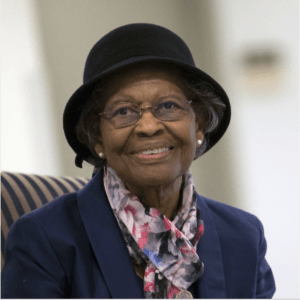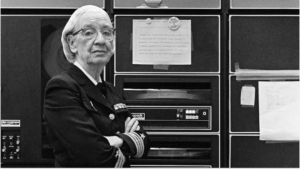17-year-old Maria Mitko shares the stories of the women behind some of our world’s inventions that have helped change our lives for the better

Dr. Gladys West is inducted into the Air Force Space and Missile Pioneers Hall of Fame during a ceremony in her honour at the Pentagon in Washington, D.C., Dec. 6, 2018.
August 6, 2024
How five overlooked female inventors changed our lives for the better
Women have made a significant impact on the world for hundreds of years. Their inventions may be widely known or used, from navigating us across the globe to saving time and lives. But do we know the faces of those behind them? Lets take a look at how their discoveries have changed our daily habits for the better, without us even noticing.
Female inventors throughout history have heavily contributed to the way our world currently works, whether it be in seemingly small contributions to ground-breaking and revolutionary ideas. Although we may have heard of Maria Skłodowska-Curie, who is known for discovering polonium and radium, there are other women who we as a society have overlooked.
At the time of creating them, each woman’s inventions were either met with enthusiasm or deemed unnecessary. But what is certain is that now we are unable to go about our daily lives without them.
Here are five female hidden figures who contributed to items or systems known and used worldwide.
Mary Anderson (1866–1953)
Mary Anderson not only established herself as an entrepreneur but is also responsible for the invention of every modern car’s component – the windshield wipers.
Brought up in Greene County, Alabama, she, her mother and sister built and moved into Fairmont Apartments in Birmingham in 1889. She left home in 1893 to operate a cattle ranch in Fresno, California, but returned after five years to take care of their sick aunt. In her aunt’s trunk, Anderson found a collection of gold and jewellery which allowed her family to live comfortably. In 1903, Mary used some of that inheritance to pay for a trip to New York City.
On that trip she found inspiration to invent a product, now used by every driver. Seeing streetcar drivers having to open their windows or even get out and clean it in order to see during snowy days, she thought of a different solution. The first version of what we now know as the windshield wiper, consisted of a lever- controlled spring-loaded arm with a rubber blade.
Anderson patented her work in the same year and it proved to be the first device of that type to actually work. She actually created windshield wipers before a single Harrison Ford’s vehicle was made. Because of negative reactions and scepticism, Anderson didn’t profit from her invention, although windshield wipers were a standard component of cars by 1913.
Nowadays it’s unthinkable to drive a car without the ability to wipe the shield during rainy or snowy days.
Anna Connelly (mid 1800s–mid 1900s)
Anna Connelly of Philadelphia invented the first steel exterior fire escape and contributed to saving countless lives.
The Triangle Waist Company Fire of 1911, which resulted in the horrific deaths of 146 people, could have been avoided if the building was equipped with exterior fire escapes. They would have allowed fire marshals to reach the upper floors, where the fire broke out and the wagons and ladders couldn’t reach.
Born in the mid-19th century, she patented her idea in 1887, before women were permitted to vote or work outside of their homes, making her one of the first women to submit an invention after the Civil War. She paved the way for other women to follow in her footsteps and take ownership in their work.
She designed an exterior staircase which prevented people from falling down flights of stairs in panic caused by emergencies. It was known as a fire escape bridge, which structure would connect buildings at the roof line. This allowed people to escape to the connected building and safely get down the stairs.
She described her invention relating to “improvements in fire-escapes”, which led to safer getaways during emergencies. It was also cost-effective as it didn’t lead to the need for remodelling the buildings. Connelly’s design was viewed positively as it held the ability to save many lives.
Very little is known about her, including her exact date of birth, but what’s certain is the impact her invention had. Connelly, one of the first female inventors, started saving lives 150 years ago and continues to do so today.
Grace Murray Hopper (1906-1992)
Grace Murray Hopper was an American computer scientist, mathematician and rear admiral in the US Navy, who contributed to the development of the first commercial electronic computer.
She graduated with a bachelor’s degree in maths and physics from Vassar College and went on to study for her PhD in mathematics at Yale University. She was one of the first few women earning such a degree.
She joined the Naval Reserve in 1943, after being an associate professor at Vassar College, and became a lieutenant assigned to the Bureau of Ordinance’s Computation Project at Harvard University a year later, where she worked alongside others on Mark I – the first large-scale automatic calculator and the father of electronic computers.
In 1946, at 40 years-old she, along with a team at the Computation Laboratory, wrote the first computer manual and extensive treatment of how to program a computer: A Manual of Operation for the Automatic Sequence Controlled Calculator.
She continued to lead her division after WWII and created the first computer language compiler which then led to the Common Business Oriented Language (COBOL) – a widely adapted language used around the world. She resumed naval service at 60 years-old for 19 years and retired in 1986, aged 79 , as a rear admiral and the oldest serving officer in the service.
She was awarded the National Medal in Technology in 1991 making her the first female individual to receive the award. Barack Obama, former US President, awarded her posthumously with the Presidential Medal of Freedom in 2016.
Marie Van Brittan Brown (1922–1999)
Marie Van Brittan Brown, an African-American nurse and inventor contributed to a safer society by creating the first home security system in the 1960s.
Learn more:
Feeling unsafe in her own home in Queens, New York, Brown thought up the prototype designs while her husband Albert Brown worked irregular hours as she was alone at night. Her neighbourhood was notoriously known at the time for its high crime rate,with the police said to be slow to respond to incidents, even when it came to emergencies.
This trailblazing system allowed the 44 year-old to immediately notify her husband and the relevant services when he wasn’t home.
The Home Security System Utilizing Television Surveillance consisted of four peepholes, a sliding camera, television monitors and two-way microphones – allowing her to view people at different heights. A remote control could be used to unlock the door and an emergency button to contact police or security. These items created a closed circuit television, better known as CCTV, making Brown the first person to make it.
In 1966, the wife and husband duo submitted the idea for a patent, which they received three years later. It has been cited in at least 32 applications since. Her home security invention was the basis for two-way communication and influenced modern home security systems, including the Ring Doorbell and video cameras.
Although it was definitely needed, many people couldn’t afford the technology but Marie’s design still made many homes across the world feel safer. She received an award from the National Scientist Committee, but her achievement and impact remains often not mentioned.
Gladys West (1930–present)
Gladys West is an African-American mathematician, whose work was crucial in the invention of GPS (Global Positioning System). Although women are recognisable as the voice of the GPS, they’re not recognised as the brain behind it.
West was born in Virginia and spent her childhood on her parents’ farm, where she used to help out. Born during the Great Depression, the mathematician’s career choice seemed to be very limited. However, Gladys graduated from high school as valedictorian which earned her a scholarship to Virginia State College (now Virginia State University). There she earned a degree in mathematics and a few years later returned for a PhD. Between her degrees, she taught mathematics at racially segregated schools in Virginia.
A year after her master’s she was hired by the US Naval Proving Ground, a weapons laboratory. Her ability to solve complex problems by hand allowed her to program computers to do it for her. One of the first major projects she took part in was the Naval Ordnance Research Calculator (NORC), an award-winning program designed to determine the movements of Pluto in relation to Neptune.
At 48 years-old, West was promoted to the manager of SeaSat – an experimental ocean surveillance satellite. Out of her work came GEOSAT, a satellite programmed to create computer models of the earth. This made it possible to determine an exact model of the earth’s shape – a ‘geoid’. Determining the exact model of the earth allowed for the creation of GPS and later updates made it possible to accurately calculate any place on earth.
Not only is this system used by countless people all over the world, it has become a ‘cornerstone’ for emergency services. Pin-pointing a person’s exact location is crucial to provide them with a timely service and it may be the determining factor in saving someone’s life.
Its importance is undeniable, yet many still have no idea that it was created largely because of a woman.




